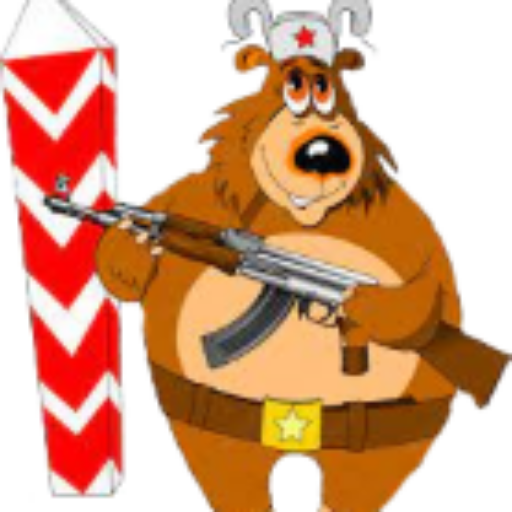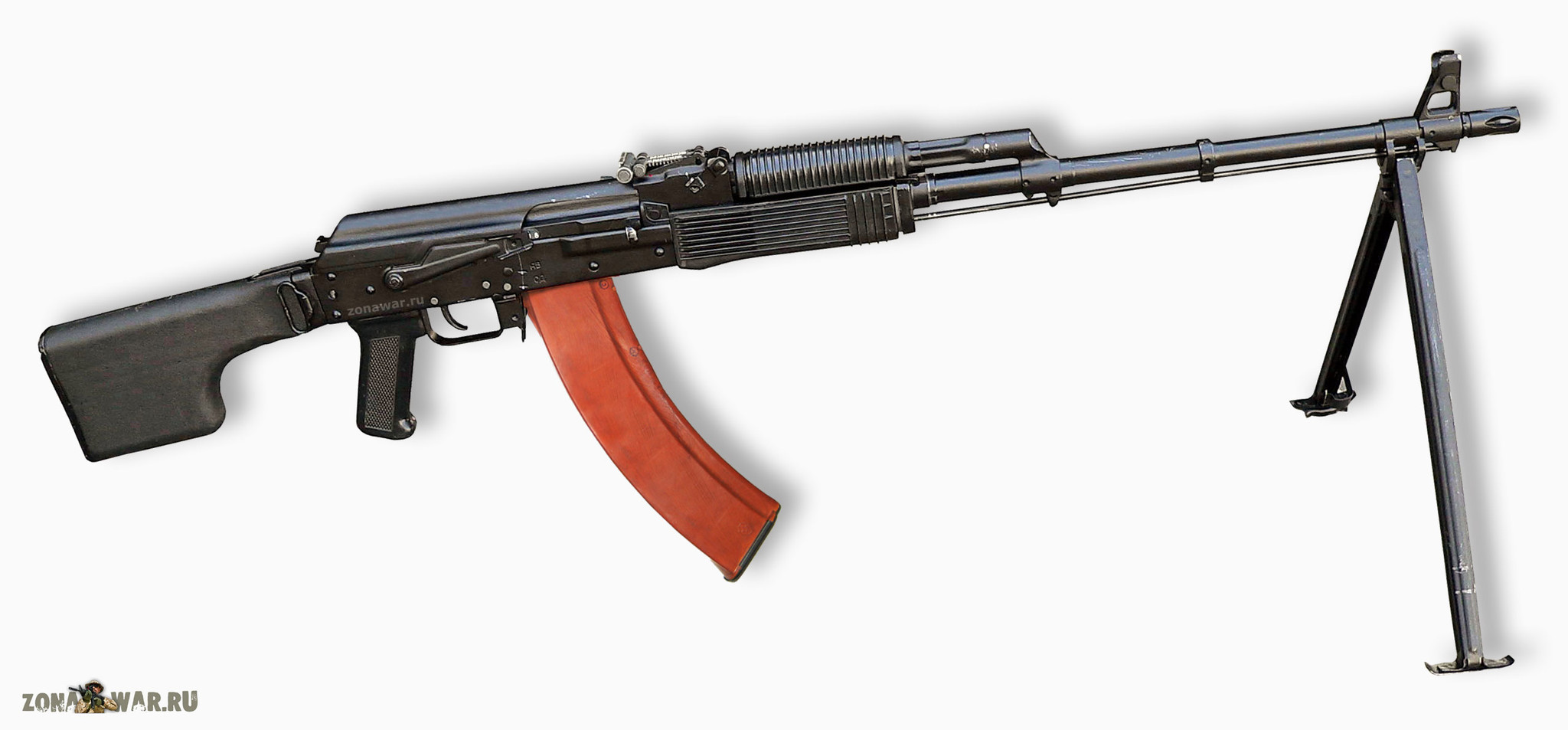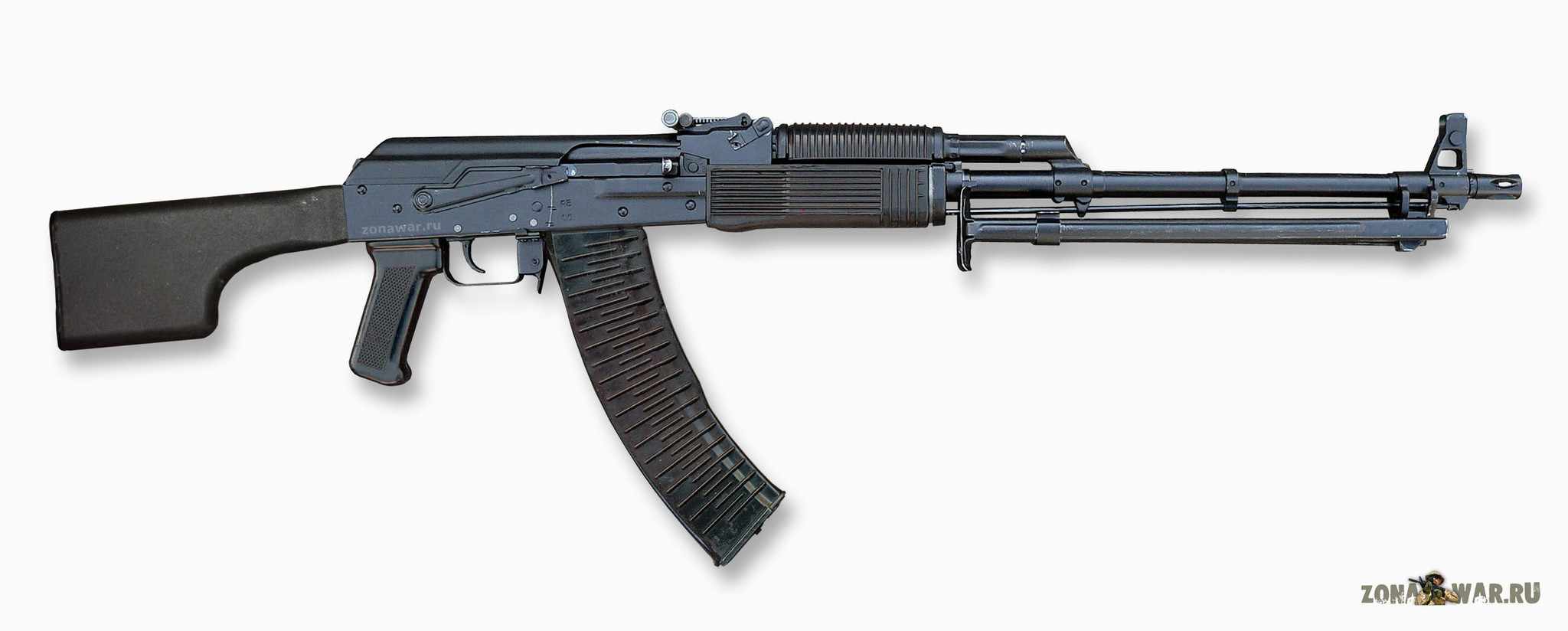 NSVS-12.7 large caliber machine gun on a 6T7 mount
NSVS-12.7 large caliber machine gun on a 6T7 mount
By the late 1960s the DShKM had failed to meet tactical maneuverability requirements: the weight of the machine gun proper (without the mount and the ammunition befit) totalled 33.5 kg, and that on a tripod and with a 50-round belt amounted to 148 kg, while the length on a tripod equalled 2,600 mm. Development of a lighter heavy machine gun, chambered for the very same 12.7 x 108 mm cartridge and intended to replace the DShKM, began in 1969. The research and development project was codenamed Utyos.
The project was pursued by a team of TsKlB SOO designers. including G. 3. Nikitin, Yu. M. Sokolov, and V. I. Volkov. Their machine gun entered the inventory in 1974 under the designation of NSV-12.7 (Nikitin-Sokolov-Volkov, 12.7 mm, index 6P11).
The machine gun is gas-operated. The gas cylinder is mounted under the barrel and fitted with a gas regulator with two lateral holes of different diameters for bleeding expanding powder gases into the cylinder and the gas piston recess.
The machine gun is fitted with a quick-change barrel attached to the receiver by a wedge latch. The barrel should be cooled or replaced after 100 shots ft can be changed without removing the machine gun from a tripod or a mount. There is a handle on the barrel or carrying the machine gun and easy replacement of the barrel.
The locking is performed by a 3-part horizontal breech block. The upper left sub-block also serves for chambenng rounds. When the breech block, lined to the breech-block assembly by stirrups, moves forward it folds to the left and its upper and lower locking lugs engage shoulders of the receiver. The breech-block assembly with a hinged gas piston is the major component. St is equipped with three rollers for moving on the receiver guide rails — the rollers make operation of the machine gun smoother and more reliable. The mainspring is accommodated in the breech-block assembly channel. The rear part of the recoil mechanism mounts a buffer spring, which reduces the impact of the recoiling breech-block assembly. The cocking handle, mounted on the right, remains fixed during firing.
The machine gun is fired from the rear sear. The trigger assembly is accommodated inside a separate housing in the upper rear part of the receiver. The trigger assembly provides for automatic fire only. It is operated by a pawl, which in its turn is linked to an electric trigger or a mechanical trigger of the machine gun mount. The manual safety blocks the sear.
Ammunition feed is from a metal-Sink belt, formed from easily managed 10-round lengths (linked by a cartridge). Feed direction may be from the left or right. The belt is drawn by a feed slide, operated by a special lug of the breechblock carrier assembly.
When the breech-block assembly recoils, the spend case is extracted from the chamber, moved along the breechblock face to the right when the breechblock carrier approaches the cartridge ejector, and held inside the breech block by the gripper. When the breech is locked again, the breech-block corner paw pushes the spend case in to the ejection chute of the receiver St is then pushed out by the next spent cartridge case. The fact that spent oases are ejected forward and the pawl-operated trigger assembly allow the NSV machine gun to be fitted on various mounts, including tank and fortification mounts.
It is worth mentioning that, a general-purpose mount was given up, and the machine gun was equipped with the 6T7 standard folding ground tripod, designed by L. V. Stepanov and K. A. Baryshev, which could not be used for anti-aircraft fire and featured a limited traverse, and the 6U6 all-around traverse anti-aircraft mount, designed under the supervision of R. Ya. Purtsen. It made the weapon system more flexible and maneuverable. The availability of several mounts, which did not require any modifications of the machine gun, offered a choice depending on the mission at hand.
When mounted on a tripod, the machine gun is designated NSV-S-12.7. The machine gun is attached to the cradle of the 6T7 tripod, which also mounts a spring-loaded skeleton butt-stock on a strut, a pistol grip, a trigger assembly, a cocking mechanism, and a sight mount. Thus, all firing controls are mounted on the tripod rather than the machine gun proper. The butt-stock and the pistol grip make machine gun handling considerably easier, while most of the recoil is absorbed by the ground through the tripod, which may move slightly. The shoulder rest allows the gunner to conducted aimed fire without digging in the tripod. When the trigger is pulled, the pawl of the machine gun trigger assembly is depressed. The cocking mechanism is of a cable type: the gunner pulls the cable handle, which rotates a drum with a star gear, operating a bar; the bar is linked with the machine gun cocking handle. The gun mount has a traverse of 10-25°, and an elevation of -8° to +10°. There is an extra folding spade on the front leg for better stability on soft ground and a shock-absorbing spring for firing on solid ground.
In march formation the folded tripod is carried by the second crewmember. During the battle the combat crew can carry the machine gun on the tripod with the help of the handle on the barrel and the butt-stock of the tripod. It is worth mentioning that the ratio of the tripod weight to the machine gun weight has changed from 3.65 of the DShKM to 0.64 of the NSV-S-12.7.
The 6T7 design allows it to be fitted on 6U10 and 6U11 mounts directly in pillbox firing ports and to be as quickly detached for use outside pillboxes. The 6U10 and 6U11 mounts were developed by L. V. Stepanov and fielded in 1976.
The SPP (1OР50) optical sight, attached to the rear part of the receiver, is the main sight of the machine gun. A gunner can also use open-type irons sights, which comprise a folding tangent leaf rear sight with a windage knob, mounted on the trigger assembly housing and a foresight mounted on the muzzle.
The NSV machine gun is also employed as an anti-aircraft weapon on warships. Designers from the Tula-based TsKlB SOO, including E. M. Kondaurov, V. E. Sokolov, I. M. Ustmkm and A. A. Lavrichenko developed the TKB-095 Ytyos-M armoured turret mount. In 1976 the turret entered service with landing craft, air cushion (LCAC), surface effect ships, and boats. The NSV-12.7 is also part of the armament of the Gorchak weapon system on a disappearing mount, designed to be used in fortified areas, road blocks, borderline areas, and crucial facilities.
Among existing heavy machine guns the NSV-12.7 features such advantages as a relatively low weight and good maneuverability. The design of the machine gun and the mount ensure precise aiming and a high accuracy of fire, while firing the machine gun on a tripod from a prone position provide for easy aiming and concealment. The NSV-12.7 has become practically the first mass-produced machine gun in a new-generation family of light heavy machine guns.
The machine gun was put into production at the Metallist plant in Uralsk, Kazakhstan, while the ground tripod for the NSV-S-12.7 is manufactured by the Vyatskie Polyany-based Molot Machine Building Plant.
The tank variant is designated NSVT index 6P17. The NSVT machine gun is installed on a mount, ensuring an elevation of -5 to +75° for engaging ground and air targets. The K10-T collimator sight is employed for firing at air targets, and iron sights are used for engaging ground targets.
The license for producing the NSVT as part of the armament of the T-72 main battle tank has been handed over to Poland, Bulgaria, and India.
Specifications NSV
Caliber: 12,7 mm
Cartridge: 12,7 x 107 DShK
Weapon weight w/o ammo load: 25 kg
Weapon weight w/cartridge belt on 6T7 mount: 41 kg
Weapon weight w/cartridge belt on universal mount 6U6: 92,5 kg
Weapon length: 1560 mm
Weapon length on mount 6T7: 1900 mm
Weapon height on mount 6T7: 380 mm
Muzzle velocity: 845 m/sec
Rate of fire: 700-800 rds/min
Effective rate of fire: 80-100 rds/min
Sighting range: 2,000 m
Thickness of a penetrated armor plate at a range of 500 m: 16 mm
Cartridge belt capacity: 50 rds




